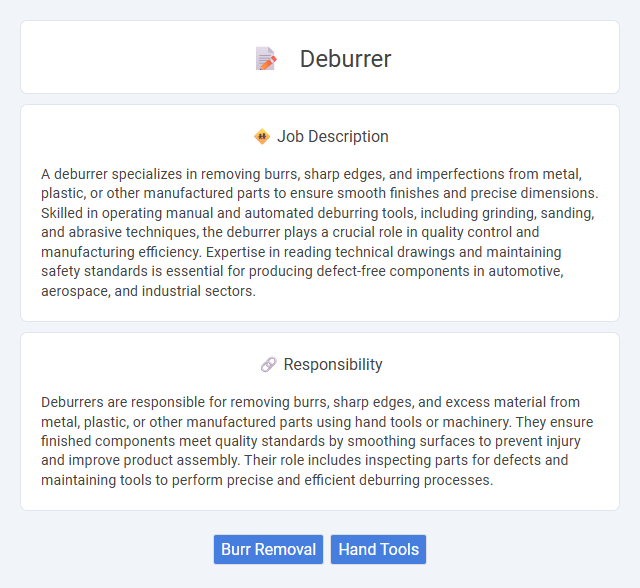
A deburrer specializes in removing burrs, sharp edges, and imperfections from metal, plastic, or other manufactured parts to ensure smooth finishes and precise dimensions. Skilled in operating manual and automated deburring tools, including grinding, sanding, and abrasive techniques, the deburrer plays a crucial role in quality control and manufacturing efficiency. Expertise in reading technical drawings and maintaining safety standards is essential for producing defect-free components in automotive, aerospace, and industrial sectors.
Individuals with good manual dexterity and keen attention to detail are likely to be well-suited for a deburrer job, as it involves precise handling and smoothing of metal or plastic components. Those who can comfortably perform repetitive tasks and maintain steady focus may find this work suitable, while people with limited hand-eye coordination or difficulty with fine motor skills might face challenges. The job may also require standing for extended periods, so individuals with physical stamina could have a higher probability of thriving in this role.
Qualification
A skilled deburrer requires proficiency in operating hand tools and machinery to remove burrs, sharp edges, or imperfections from metal, plastic, or glass components. Candidates must possess strong attention to detail, manual dexterity, and the ability to interpret technical drawings and specifications accurately. Prior experience in manufacturing or metalworking environments and basic knowledge of safety protocols enhance job performance and qualification.
Responsibility
Deburrers are responsible for removing burrs, sharp edges, and excess material from metal, plastic, or other manufactured parts using hand tools or machinery. They ensure finished components meet quality standards by smoothing surfaces to prevent injury and improve product assembly. Their role includes inspecting parts for defects and maintaining tools to perform precise and efficient deburring processes.
Benefit
A deburrer role likely offers benefits such as improved manual dexterity and attention to detail, which can enhance overall craftsmanship. Employees may experience reduced risk of part defects, contributing to higher product quality and customer satisfaction. There is a probability that consistent work in this position leads to skill development valuable for manufacturing and engineering careers.
Challenge
Deburring jobs likely present significant challenges due to the precision required to remove sharp edges without damaging the parts. The probability of encountering inconsistent material surfaces can increase the difficulty, demanding adaptive techniques and careful attention to detail. Workers probably face ongoing pressure to maintain both safety standards and high-quality finishes under tight production schedules.
Career Advancement
A deburrer enhances metal and plastic components by removing burrs and sharp edges to ensure product quality and safety. Mastery of precision tools and techniques opens pathways to roles such as quality control inspector, manufacturing technician, or process engineer. Pursuing certifications in manufacturing processes and advanced machining technologies significantly accelerates career progression in industrial settings.
Key Terms
Burr Removal
Deburrers specialize in burr removal to enhance the precision and safety of machined parts. Using tools like abrasive wheels, brushes, and cutting blades, they eliminate sharp edges and residual material from metal, plastic, or composite components. Effective burr removal improves product quality, reduces assembly issues, and prevents injury in manufacturing processes.
Hand Tools
Deburrers equipped with hand tools effectively remove sharp edges and burrs from metal, plastic, and wood surfaces, enhancing product quality and safety. Precision hand deburring tools, including scrapers, files, and rotary instruments, allow for meticulous control, reducing the risk of damage to delicate parts. Skilled operators leverage ergonomic hand deburring tools to optimize workflow efficiency and maintain consistent finish standards across manufacturing and maintenance processes.
 kuljobs.com
kuljobs.com